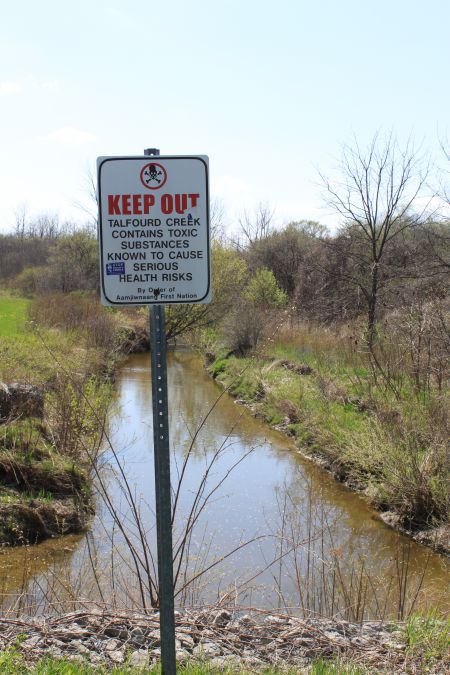"How polluted is the creek that runs through our community?" That is what members of Aamjiwnaang First Nation want to know and it’s an important question considering they live in an area known as Chemical Valley.
Through the years piecemeal studies have been done on the aquatic life, air as well as the residents themselves. The results have frequently been alarming. In 1996 the Ministry of the Environment recorded high levels of mercury in plant and marine life, in 2011 the World Health Organization listed neighbouring Sarnia as having the worst air quality in Canada, and a 10 year birth ratio study presented in 2005 showed an alarming trend that the number of boys being born was steadily declining.
But most recently representatives of the Ministry of the Environment and Climate Change (MOECC) presented a new report that said the local creek was fine to play in.
On May 14, five representatives of the MOECC presented the report: Screening Level Human Health Risk Assessment of Recreational Use of Talfourd Creek, Ontario at the Maawn Doosh Gumig Community and Youth Centre in Aamjiwnaang. The Ministry looked at water and sediment samples from a number of locations along the creek and tracked six chemicals; cadmium, manganese, titanium, polycyclic aromatic hydrocarbons, octachlorostyrene and 2,6-dichlorobenzyl chloride.
The representatives explained that from their test results Talfourd Creek should not be considered a danger, stating; “Based on the assessment in this screening level risk assessment, exposures to contaminants in Talfourd Creek reflect negligible additional risk to a frequent recreator” (a person who uses the creek for recreational purposes).
But these findings and the report's conclusion run contrary to the community's experience. Many of the people at the presentation cited examples of animals becoming sick after drinking the water, catching deformed fish, and children experiencing skin rashes after playing in the creek. They also asked if the Ministry examined the creek's plants and fish or factored in the cumulative effect of all the chemicals found in the water as well as air. The representatives conceded that these were not aspects of the study. The report’s summary acknowledges this limitation stating, “It is important to note that this risk assessment reflects only the additional risk a person would have from recreational use of Talfourd Creek, not the total risk a person would have from all sources of exposure to a contaminant in Lambton County.”
This latest Government report appears to be another in the growing list of inconclusive studies that neither reveals a reason for the resident's reported health issues nor convincingly proves that there are no hazards to living in the area. It is because of this that the youth led group ASAP (Aamjiwnaang and Sarnia Against Pipelines) is spearheading a independent toxicity study.
The group explains their rationale saying:
"It is important to empower ourselves as stewards of the water, as government and industry have downplayed, ignored and actively worked to repress information about water pollution in Chemical Valley. By conducting our own water testing of pollutants in our territories, we build the knowledge, skills, and resources to get answers about long standing questions about the level and nature of contamination in Aamjiwnaang."
Throughout the summer, members will be meeting with the community, taking samples of water and sediment from the creek, working with labs and university partners to examine the samples then compiling a report based on the results. In September they plan to have the project completed and are organizing a Toxic Tour to both present the results and provide a context to non-residents for why the project was needed.
To help fund the project, ASAP created a crowdfunding page and updates to the project's progress will be posted on their web site.
Anyone interested in pollution, environmental justice, popular epidemiology, effects of the tar sands developments including its pipelines, is encouraged to join the Toxic Tour. Information about the event and how to sign up will be posted on the groups Facebook page.

